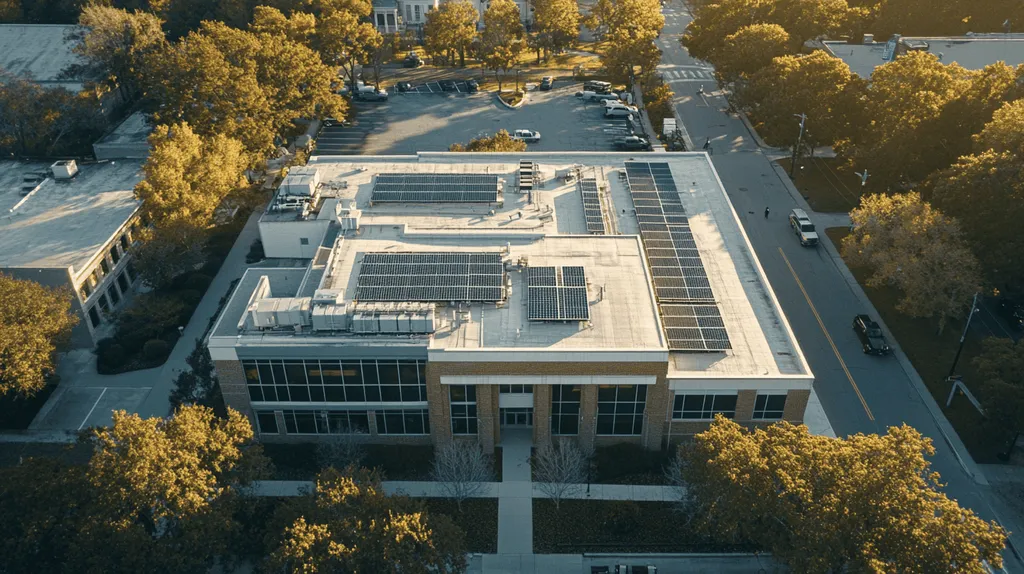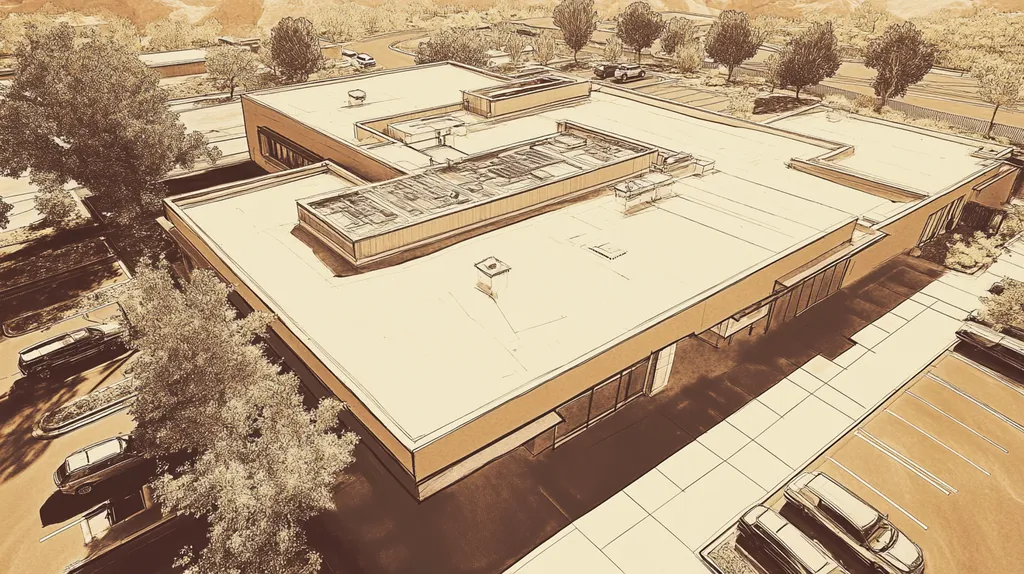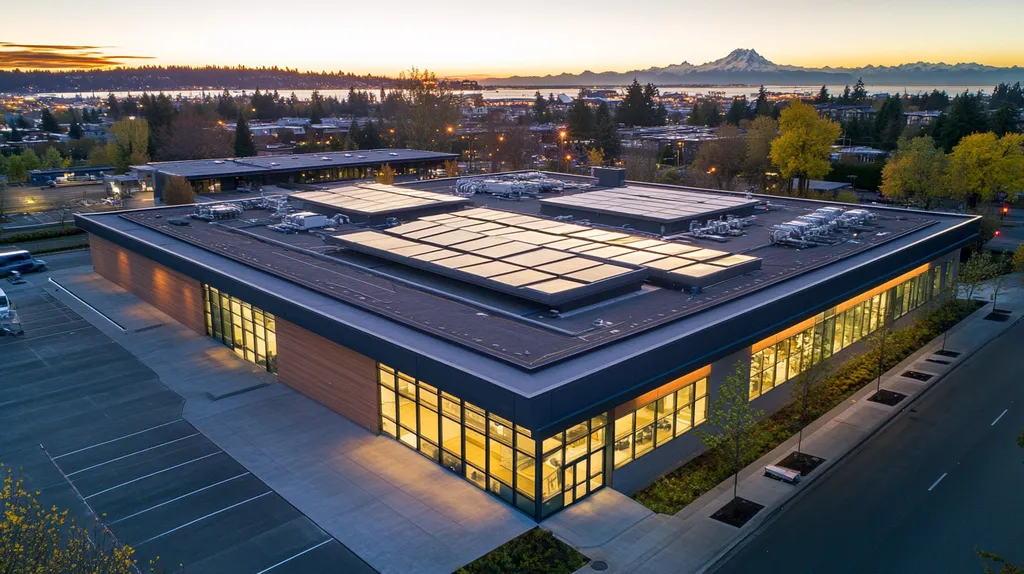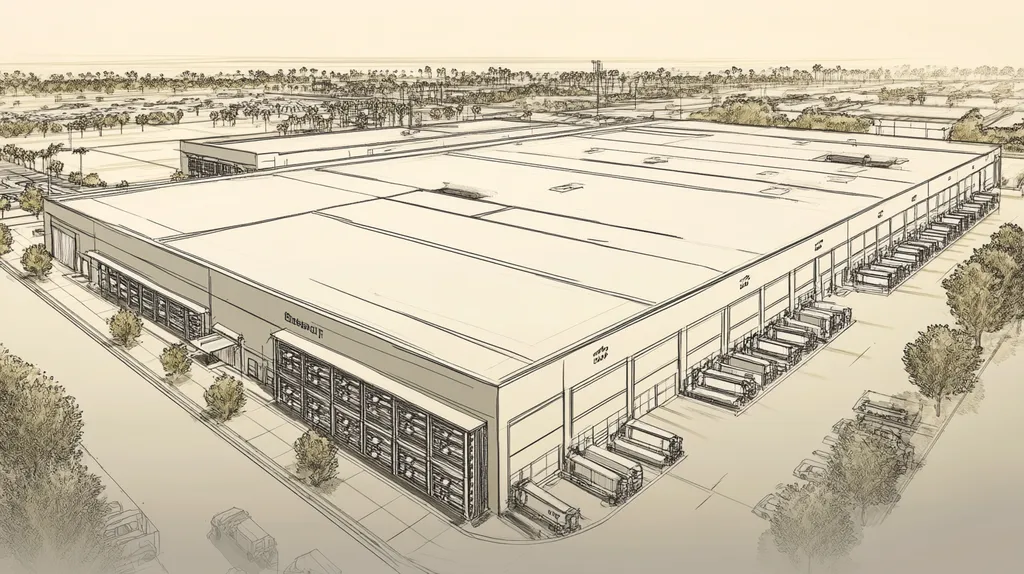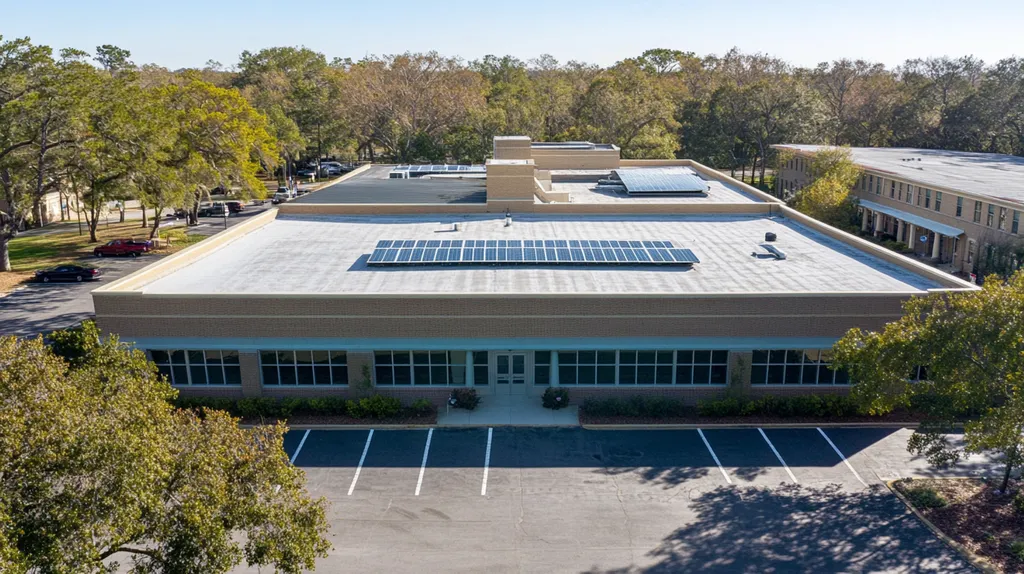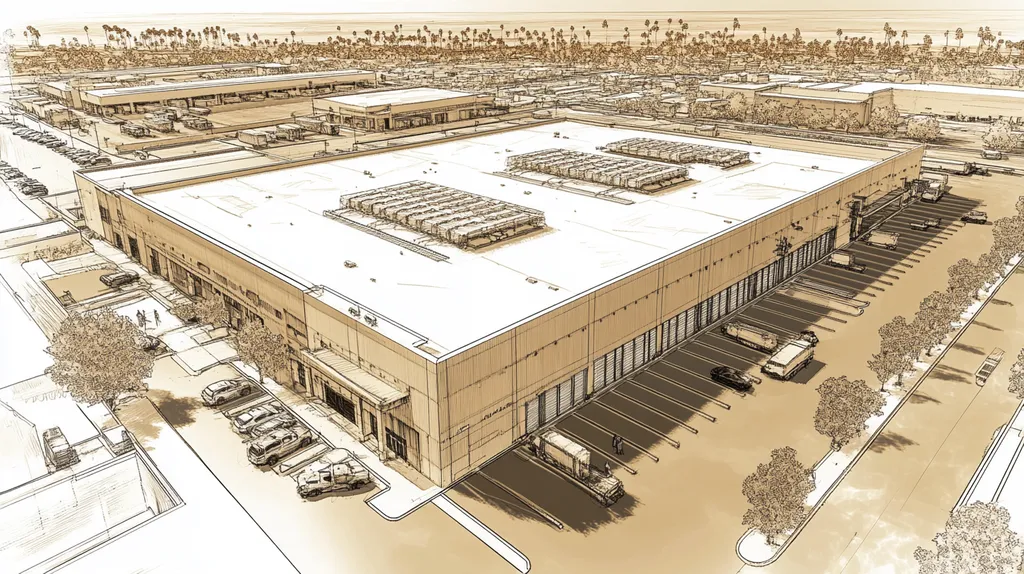When a Chicago manufacturing plant’s roof replacement stretched from six weeks to four months due to weather delays, the project budget ballooned by 60% while operations faced repeated shutdowns.
Weather doesn’t just inconvenience commercial roofing projects—it controls them entirely, turning predictable timelines into costly disasters.
Understanding how temperature, precipitation, and wind affect roofing schedules isn’t optional planning—it’s essential protection for your building and budget.
This guide breaks down weather impacts, cost considerations, and practical strategies that transform unpredictable roofing projects into manageable investments.
SECTION 1: THE BASICS EXPLAINED
Picture this: your roofing crew arrives Monday morning ready to install a new membrane system, but unexpected thunderstorms roll in and shut down work for three days. Meanwhile, your building sits partially exposed, vulnerable to water damage that could cost tens of thousands in repairs.
Weather doesn’t just inconvenience commercial roofing projects—it can derail them entirely. Understanding how Mother Nature impacts your roofing timeline isn’t just helpful planning; it’s essential protection for your building and your budget.
What It Is (In Plain Language)
Weather effects are simply how natural conditions—rain, wind, temperature, and humidity—control when and how roofing work can happen. Think of it like trying to paint your house exterior: you wouldn’t start if rain was coming, and the paint won’t stick properly in freezing temperatures.
Commercial roofing materials are even more finicky than house paint. Roofing adhesives need dry surfaces and specific temperature ranges to bond correctly, usually between 45°F and 85°F.
Single-ply membranes become brittle in cold weather and can crack during installation. Meanwhile, asphalt-based materials become too soft in extreme heat, making them difficult to work with safely.
Wind speeds above 25 mph turn lightweight roofing materials into dangerous projectiles. Even light rain can prevent proper adhesion and create slip hazards for crews working on steep surfaces.
These aren’t minor inconveniences—they’re hard stops that can pause work for days or weeks. Smart facility managers build these weather realities into their project expectations from day one.
Why It Matters (To Your Building)
When roofing work gets rushed during poor weather conditions, your building pays the price for years to come. Materials that don’t cure properly create weak spots that turn into expensive leak problems down the road.
A partially completed roof acts like a giant funnel, directing water exactly where you don’t want it. One unexpected downpour on an exposed roof deck can damage equipment, inventory, and building interiors worth far more than the roofing project itself.
Weather delays also create scheduling domino effects that ripple through your entire facility maintenance plan. That HVAC upgrade scheduled right after roofing? It might get pushed back months if weather extends your roof timeline.
Insurance companies take note of weather-related roofing failures too. Claims from improperly installed roofs can increase your premiums and complicate future coverage.
The smartest property managers treat weather planning as insurance for their investment. A roof installed under proper conditions typically lasts 20-30% longer than one rushed through marginal weather.
How It Works
Professional roofing contractors monitor weather forecasts like ship captains watching storm patterns. They track temperature trends, precipitation probability, wind speeds, and humidity levels up to two weeks ahead.
Different roofing systems have different weather requirements, like recipes that need specific conditions to turn out right. EPDM rubber membranes need temperatures above 40°F for flexibility, while TPO systems require low wind and dry conditions for heat welding.
Smart contractors build weather buffers into every timeline—typically 20-30% extra time for seasonal projects. They also plan material deliveries around forecast windows to avoid having supplies damaged by unexpected storms.
Communication becomes crucial when weather changes plans. Contractors should notify property managers immediately when conditions force delays, explaining exactly what weather factors are causing the pause.
The best roofing partnerships include clear weather protocols upfront. This means defining acceptable working conditions, establishing communication schedules, and agreeing on how weather delays affect project costs and timelines.
SECTION 2: PRACTICAL APPLICATIONS
When a Chicago distribution center’s roof replacement stretched from six weeks to four months due to weather delays, the facility manager learned an expensive lesson about Mother Nature’s control over commercial roofing schedules. The project’s budget ballooned by 40% while operations suffered from repeated weather-related shutdowns.
This scenario plays out across thousands of commercial properties every year. Weather doesn’t just delay roofing work—it transforms straightforward projects into complex logistical puzzles that ripple through entire building systems.
Common Uses & Examples
Think of weather planning like checking road conditions before a long trip—smart facility managers do it for every roofing decision. Large retail chains routinely schedule roof replacements during their slowest seasons, building in extra weeks for weather delays to avoid disrupting peak shopping periods.
Manufacturing facilities use weather windows strategically for roof maintenance. A pharmaceutical plant might schedule membrane repairs during their planned summer shutdown, knowing that unexpected storms could extend work into production time.
Extreme temperatures make installation tricky since high heat softens shingles while cold weather can make them brittle. Rain halts progress completely because roofing materials need dry conditions for proper adhesion (source: Hired Guns Roofing & Restoration).
Emergency repairs showcase weather planning under pressure. When hail damages a hospital’s roof, facility managers must balance immediate protection needs against safe working conditions for crews.
Office building managers often coordinate roof work with tenant lease renewals. Weather delays that push roofing into occupied periods can trigger tenant complaints and even lease disputes over disrupted operations.
When You Need It Most
Spring emerges as the make-or-break season for commercial roofing schedules. Contractors scramble to complete winter damage repairs before the busy summer construction season, making weather windows incredibly valuable.
Hurricane season transforms routine maintenance into crisis management. Coastal facilities must complete roof work before storm season arrives, or risk having partially finished projects become flying debris during high winds.
School districts face the ultimate weather deadline pressure. Summer break offers the only feasible window for major roof work, and weather delays can force incomplete projects into the new school year.
Retail properties experience peak urgency during pre-holiday seasons. A shopping center’s roof leak during Black Friday weekend costs far more than the repair itself—it damages tenant relationships and holiday revenue.
Cold storage facilities can’t afford weather delays that expose their buildings. Even brief exposure to rain or snow can compromise insulation systems that keep frozen goods at proper temperatures.
Interactions With Other Systems
Picture your building like a carefully choreographed dance where every system depends on the others. Weather delays in roofing throw off this entire performance, creating cascading problems throughout your facility.
HVAC installations wait for completed roofs before final connections. Weather-delayed roofing pushes HVAC work into peak summer months when equipment costs more and technicians charge premium rates for hot-weather installations.
New insulation systems become worthless if unexpected rain soaks them during installation. Wet insulation loses its thermal properties permanently, forcing complete replacement and doubling material costs.
Solar panel installations depend on dry, stable roof surfaces. Weather delays that push solar work into winter months can eliminate valuable tax incentives tied to calendar-year completion deadlines.
Fire suppression systems often require roof penetrations that must be sealed immediately. Weather delays create windows where these critical safety systems remain partially offline, potentially violating building codes and insurance requirements.
SECTION 3: KEY TERMINOLOGY DECODED
When a facility manager tells their roofing contractor to “proceed when conditions are acceptable,” both parties might have completely different definitions of “acceptable.” This miscommunication can lead to installation disasters, warranty voids, and expensive repairs.
Weather-related roofing terminology isn’t just industry jargon—it’s the precise language that determines when your project moves forward or grinds to a halt. Understanding these terms empowers property managers to make informed decisions and hold contractors accountable for proper timing.
Essential Terms Explained
Think of “dew point” as nature’s invisible deadline for your roofing project. It’s the exact temperature where moisture in the air condenses into water droplets on surfaces—like fog forming on your bathroom mirror after a hot shower.
When roof surfaces drop to the dew point temperature, they become wet even without rain. Installing roofing materials on these seemingly dry but actually moisture-covered surfaces creates adhesion problems that show up as leaks months later.
“Wind uplift” measures how much upward pressure wind creates on your roof—imagine Mother Nature trying to peel your roof off like removing a Band-Aid. Wind speeds above 25 mph create enough uplift force to turn lightweight membrane materials into dangerous flying carpets.
“Thermal cycling” describes how roofing materials expand when heated and contract when cooled, like a balloon growing and shrinking. Installing materials during rapid temperature swings—say, a 40-degree temperature drop overnight—can create stress cracks before the roof even protects its first rainstorm.
Professional contractors monitor these conditions constantly because understanding when nature cooperates versus when it fights back determines project success. Smart facility managers learn these terms to speak the same language as their roofing teams.
Industry Jargon Translated
“Substrate moisture content” sounds technical, but it simply means how much water your roof deck has absorbed—like checking if a sponge is dry before painting over it. Wet substrates prevent proper adhesive bonding and can trap moisture that causes rot and mold.
When contractors mention “flash-off time,” they’re talking about how long solvents in roofing materials need to evaporate before the next installation step. Think of it like waiting for nail polish to dry completely before applying a second coat.
“Ambient conditions” refers to the surrounding air temperature, humidity, and pressure that affect how roofing materials behave. Cold ambient conditions make materials brittle, while hot conditions make them too soft to handle safely.
“Cure time” indicates how long roofing materials need under specific conditions to reach full strength—like concrete needing time to harden. Rushing cure time by ignoring weather requirements creates weak bonds that fail prematurely.
Understanding these translated terms helps property managers recognize when contractors are making excuses versus explaining legitimate weather constraints. Weather conditions can impact timelines significantly, as adverse weather might halt work during unfavorable periods (source: NA Roofing).
Measurement & Units Simplified
Weather measurements act like a recipe for successful roofing—get the ingredients wrong, and the whole project fails. Temperature thresholds typically require minimums above 40°F for most adhesives to bond properly, while maximums below 85°F prevent materials from becoming dangerously soft.
Relative humidity readings above 85% spell trouble for most roofing installations because materials can’t dry properly in saturated air. It’s like trying to dry laundry in a steamy bathroom—technically possible, but incredibly slow and unreliable.
Precipitation measurements matter more than most people realize. Even 0.1 inches of rain can saturate roofing substrates and delay work for days, while forecasts showing 0.3 inches or more typically shut down projects completely.
Barometric pressure changes signal approaching weather fronts that smart contractors use for timing decisions. Rapidly dropping pressure often precedes storms by 12-24 hours, giving experienced crews time to secure materials and work areas.
Wind speed thresholds create hard stops for different roofing activities—15 mph limits work with lightweight materials, 25 mph halts membrane installation, and 35 mph shuts down all elevated work for safety reasons.
SECTION 4: DECISION FACTORS
When a Texas manufacturing plant faced a two-week weather delay on their roof replacement, the facility manager discovered their “budget-friendly” material choice would cost an extra $50,000 in overtime and equipment rental fees. Weather doesn’t just disrupt timelines—it exposes every weakness in your roofing decisions.
Smart property managers know that weather delays reveal the true cost of roofing choices. The cheapest bid often becomes the most expensive mistake when storms hit mid-project.
Cost Considerations
Think of weather delays like traffic jams—they don’t just slow you down, they cost money every minute you’re stuck. When rain shuts down a roofing project for three days, you’re still paying for equipment rental, site security, and crew standby time.
The temptation to choose the lowest-bid roofing system often backfires when weather strikes. Cheaper materials typically require more precise installation conditions, meaning they shut down work faster when weather turns bad.
Premium roofing systems with wider weather tolerance windows actually save money during unpredictable seasons. A membrane that can be installed in light rain versus one that requires bone-dry conditions could mean the difference between finishing on time and paying double in delay costs.
Weather conditions can also impact timelines, as adverse weather might halt work during unfavorable periods (source: NA Roofing). Smart facility managers budget an extra 25-30% for weather contingencies rather than hoping for perfect conditions.
Consider weather delays like insurance premiums—paying a bit more upfront for weather-resistant materials beats paying massive overruns when Mother Nature doesn’t cooperate with your timeline.
Performance Trade-offs
Picture choosing between a sports car and a pickup truck—both get you places, but they handle rough roads very differently. Fast-install roofing systems promise quick completion but often demand perfect weather conditions to perform properly.
Single-ply membranes can be installed rapidly in ideal conditions but become nearly impossible to work with when temperatures drop below 50°F or winds exceed 15 mph. Built-up roofing takes longer but soldiers through marginal weather that would shut down membrane installation.
Adhesive-applied systems offer speed and simplicity but fail catastrophically if rain hits before full cure time. Mechanically attached systems take more labor but laugh off unexpected showers that would ruin adhesive bonds.
Heat-welded seams create incredibly strong bonds but require dry surfaces and calm winds that may not exist during your project window. Tape-seamed systems work in more weather conditions but sacrifice some long-term durability.
The best roofing choice balances your local weather patterns with your project timeline. A system that installs 20% slower but works in twice as many weather conditions often finishes projects faster than “fast” systems waiting for perfect conditions.
Lifespan & Durability Factors
Installing roofing materials in poor weather conditions is like baking a cake at the wrong temperature—it might look fine initially, but problems show up later. Membranes installed during marginal weather often develop premature failures that cut roof life in half.
Weather-stressed installations create weak points that Mother Nature exploits for decades. An EPDM membrane installed at 35°F becomes brittle and prone to cracking, while TPO welded in high humidity develops seam failures within five years instead of lasting twenty.
Climate-matched roofing systems cost more initially but pay dividends through extended service life. A cool roof membrane that reflects heat in Phoenix performs differently than one designed for freeze-thaw cycles in Chicago.
Think of durability like choosing winter tires—you pay more for materials engineered to handle your specific weather challenges, but they last longer and perform better than generic solutions. Roof coatings that resist UV damage extend membrane life by 30-40% in sunny climates.
The smartest facility managers choose roofing systems proven to handle their worst local weather conditions, not just average conditions. A roof that survives your climate’s extremes will cruise through normal weather for decades.
SECTION 5: COMMON CHALLENGES
Last month, a Seattle office complex watched their $200,000 roof replacement balloon to $340,000 when unexpected Pacific storms turned a six-week project into a four-month ordeal. What started as routine membrane installation became a perfect storm of weather-related complications that facility managers face nationwide.
Weather challenges don’t announce themselves with warning sirens—they sneak up through seemingly minor forecast changes and catch unprepared roofing teams off guard. The difference between successful projects and budget disasters often comes down to recognizing weather threats before they derail timelines.
Smart facility managers arm themselves with knowledge about common weather pitfalls, early warning signals, and proven prevention strategies that keep projects moving forward despite Mother Nature’s interference.
Frequent Problems & Solutions
Picture this nightmare scenario: your roofing crew applies adhesive on Tuesday morning, then afternoon thunderstorms wash it away before it cures. Moisture infiltration during installation ranks as the top weather-related project killer, turning properly planned work into expensive do-overs.
Wind uplift creates another common disaster when gusts catch partially installed membrane systems like giant sails. Materials designed to protect buildings become dangerous projectiles that damage neighboring properties and shut down entire construction sites.
Temperature swings wreak havoc on material performance in ways most facility managers never expect. A roofing system installed during a 70-degree afternoon might crack overnight when temperatures plummet to 30 degrees, creating immediate leak paths.
The smartest contractors solve these problems before they start by using staged installation techniques that protect work in progress. Temporary weather barriers and rapid-cure materials designed for unpredictable conditions can turn potential disasters into minor inconveniences.
Real-time weather monitoring systems now alert crews to approaching problems hours before they arrive. Planning your project during favorable seasons—typically spring to fall—can help ensure a smoother process (source: NA Roofing).
Warning Signs To Watch For
Think of your roofing project like a patient showing symptoms—early warning signs can prevent minor issues from becoming major emergencies. Bubbling or blistering on newly installed membranes often signals trapped moisture that will cause leaks within months.
When adhesives or sealants take significantly longer to cure than expected, humidity levels or temperatures have moved outside acceptable ranges. These delays cascade through project schedules and signal potential bond failures down the road.
Weather forecast changes deserve immediate attention, especially when storms appear suddenly in previously clear predictions. A 30% chance of rain can shut down critical installation phases that require completely dry conditions.
Crew behavior offers valuable clues about developing weather problems. Experienced roofers start securing materials and covering work areas before weather services issue official warnings—watch for these early preparations.
Surface condensation appearing on roofing materials during seemingly dry conditions indicates dew point problems that prevent proper adhesion. Even invisible moisture can ruin installation quality and void material warranties.
Preventative Approaches
Smart facility managers build weather resilience into their roofing projects from day one, like buying flood insurance before the hurricane hits. Selecting materials with wider weather tolerance windows costs more upfront but prevents expensive delays when conditions turn marginal.
Timeline buffers act like financial emergency funds—you hope you won’t need them, but they save projects when problems arise. Adding 25-30% extra time for weather contingencies transforms potential disasters into manageable delays.
Temporary protection systems, including portable enclosures and heavy-duty tarping, allow work to continue through light rain and wind. These tools turn weather-sensitive projects into all-weather operations that maintain momentum regardless of forecasts.
Weather-trained crews understand how to protect materials and adjust techniques based on changing conditions. Investing in specialized training prevents costly mistakes that occur when workers push forward during inappropriate weather windows.
Seasonal scheduling strategies align major roofing work with your region’s most predictable weather patterns. Hurricane-prone areas complete projects before storm season, while northern climates avoid winter installation challenges that create spring emergency repairs.
SECTION 6: NEXT STEPS & RESOURCES
When a Minnesota healthcare facility discovered their roofing contractor had no weather contingency plan, a simple membrane replacement turned into a six-month nightmare that exposed patient areas to water damage. The facility manager realized too late that they’d asked about price and timeline, but never questioned weather preparedness.
Smart facility managers don’t just hire roofing contractors—they partner with weather-savvy professionals who understand that Mother Nature writes the real project schedule. The right questions, standards, and ongoing education transform weather challenges from budget-busting surprises into manageable project variables.
Questions To Ask Providers
Think of contractor interviews like job interviews—the best candidates come prepared with detailed weather strategies, not just generic promises. Ask potential contractors how they monitor local weather conditions and what specific tools they use to make go/no-go decisions each morning.
Demand to see their weather contingency plans, including how they protect partially completed work and what backup scheduling options they maintain. Contractors without written weather protocols are essentially gambling with your building’s safety.
Question their experience with your region’s specific weather challenges—hurricane seasons, freeze-thaw cycles, or desert heat waves. Generic answers signal inexperience that could cost you thousands in weather-related delays and mistakes.
Ask about their crew’s weather training and safety protocols for working in marginal conditions. Weather delays affect commercial roof installation by 5 to 10 days annually on average, making experienced crews essential for managing inevitable setbacks (source: Litespeed Construction).
Finally, clarify exactly how weather delays affect project costs and timelines. Contractors who can’t explain their weather policies in plain language probably don’t have effective ones.
Industry Standards & Guidelines
Picture industry standards like recipe instructions for successful roofing—ignore the temperature requirements, and your project fails regardless of material quality. NRCA guidelines specify minimum installation temperatures, typically 45°F for most membrane systems and adhesives.
ASTM standards provide the technical backbone for weather-related installation requirements, covering everything from substrate moisture limits to wind speed thresholds. These aren’t suggestions—they’re the engineering requirements that separate professional installations from expensive failures.
Local building codes often incorporate weather-specific provisions that reflect your region’s climate challenges. Coastal areas might require enhanced wind resistance, while northern climates demand freeze-resistant installation techniques.
Smart facility managers reference these standards in their contracts to establish clear performance expectations. When contractors understand they’ll be held to industry standards, they take weather planning seriously from day one.
Insurance companies increasingly audit roofing installations against these standards. Non-compliant work can void coverage and leave property owners financially exposed when weather-related failures occur.
Further Learning Simplified
Weather patterns change, and roofing technology evolves—staying informed protects your building investments from becoming expensive lessons in outdated practices. NRCA webinars offer monthly updates on weather-related challenges and material innovations that affect commercial roofing timelines.
The Roof Consultants Institute provides accessible online courses designed specifically for facility managers who need weather literacy without engineering degrees. These courses translate complex meteorology into practical decision-making tools.
Trade publications like Professional Roofing magazine feature seasonal articles about weather planning strategies and regional climate considerations. Reading these resources during your off-season prepares you for smarter contractor discussions.
Building relationships with local meteorologists or weather services gives you advanced warning of seasonal patterns that affect roofing schedules. Many commercial weather services offer construction-specific forecasting that helps time projects around favorable conditions.
Remember that weather education never stops—climate patterns shift, and new materials offer different weather tolerances. Continuous learning transforms weather challenges from project killers into manageable scheduling variables.
The Bottom Line
Weather doesn’t just delay commercial roofing projects—it controls every aspect of timeline success and budget reality.
Facility managers who treat weather as an afterthought watch routine maintenance transform into operational nightmares costing 40-60% more than planned.
Understanding temperature thresholds, precipitation limits, and wind restrictions empowers property owners to make informed decisions that protect both buildings and budgets.
Smart contractors build weather buffers into timelines, use materials suited to local conditions, and maintain clear communication protocols when Mother Nature intervenes.
The difference between successful roofing investments and expensive disasters comes down to one simple principle: respect weather’s absolute authority over your project schedule.
Plan for delays, choose weather-appropriate materials, and partner with contractors who understand that nature writes the real timeline—your building depends on it.
FREQUENTLY ASKED QUESTIONS
Q. How does weather impact commercial roof project timelines?
A. Weather controls when roofing work can safely proceed, like rain or freezing temperatures halting progress. Just as you wouldn’t paint outside in the rain, roofing materials need dry, moderate conditions to bond correctly. Unexpected storms or high winds can pause construction for days, turning simple schedules into costly delays.
Q. What practical steps manage weather risks for an industrial roof project?
A. Facility managers schedule roofing during favorable seasons and build in extra time for weather delays to keep operations smooth. Like checking a road trip’s weather before driving, selecting a roof installation window avoids surprises. Temporary protection and flexible planning help keep work moving even when conditions change unexpectedly.
Q. What key weather terms should I understand about commercial roofing?
A. Terms like “dew point,” when moisture condenses on surfaces, and “wind uplift,” the force that can lift roofing materials off the building, are crucial. Knowing these helps you understand why work stops during certain conditions. It’s like knowing road signs before driving—these terms warn when it’s unsafe to continue roofing installation.
Q. How do weather delays reveal true costs in commercial roof choices?
A. Cheaper roofing materials often need perfect conditions, so bad weather causes expensive schedule overruns. It’s like buying a sports car that can’t handle rough roads—delays and extra labor add up quickly. Spending more upfront on weather-tolerant systems usually saves money by avoiding costly downtime and premature repairs.
Q. What common weather-related problems delay commercial roof projects?
A. Moisture during installation, strong winds lifting membranes, and temperature swings causing cracks are typical issues. Like trying to drive through fog or strong gusts, roofing crews face hazards that force shutdowns. Early warnings, staged work, and protective coverings help turn these challenges into manageable delays.
Q. What questions should I ask roofing contractors about weather preparedness?
A. Ask how they monitor weather, what tools guide their go/no-go decisions, and for written contingency plans. Like hiring a pilot who checks weather charts before flying, you want contractors who understand local conditions and can adjust schedules proactively. Clear communication about cost impacts from weather delays is also essential.
Q. How do seasonal weather patterns affect commercial roof maintenance schedules?
A. Different seasons bring unique challenges—spring rains, summer heat, or winter freezes can all delay work or damage materials. Like farmers planting crops at the right season, scheduling roofing during predictable weather windows reduces risks and avoids costly interruptions. Aligning projects with local climate patterns ensures smoother, faster completions.

